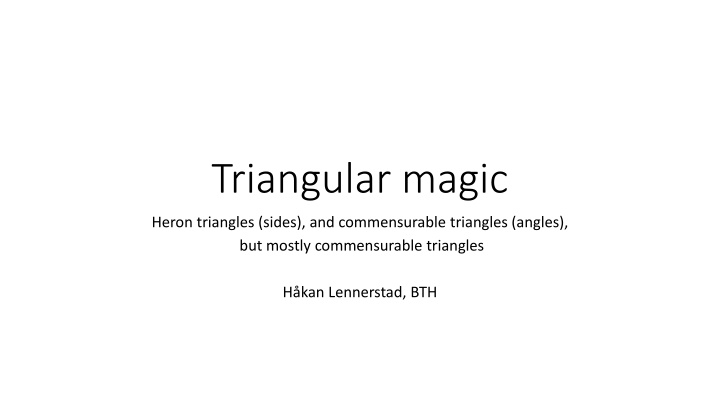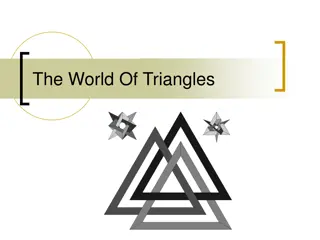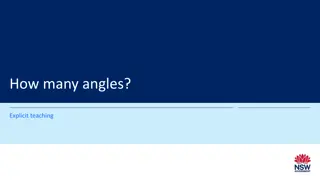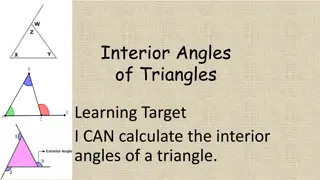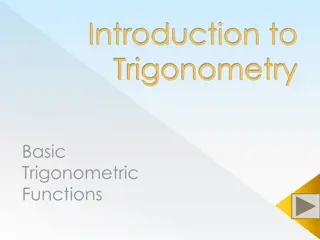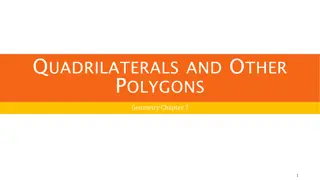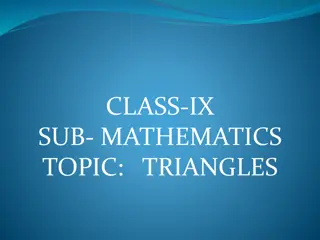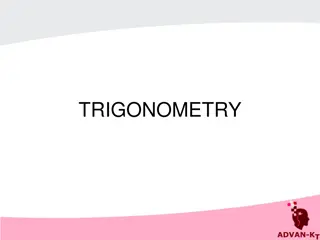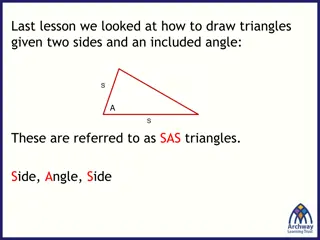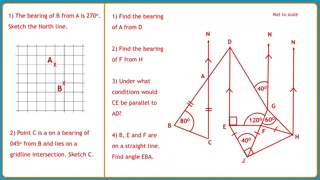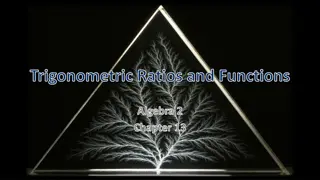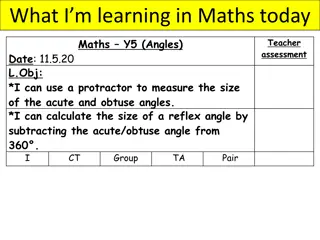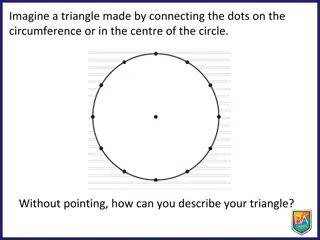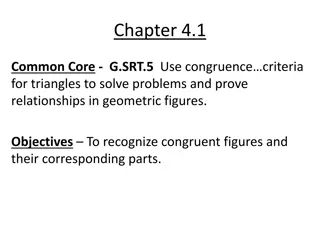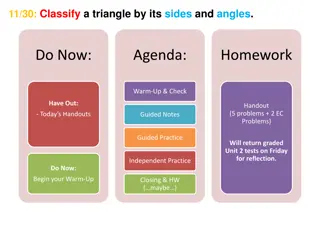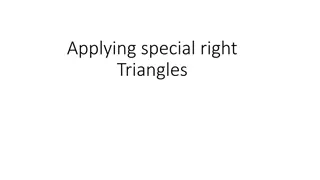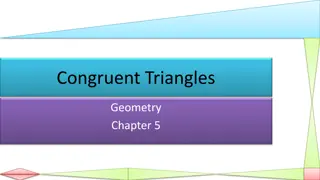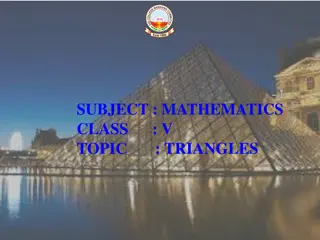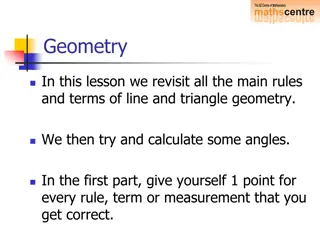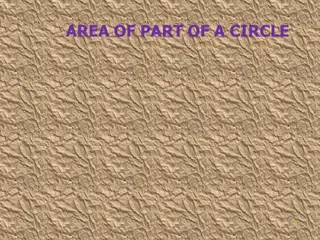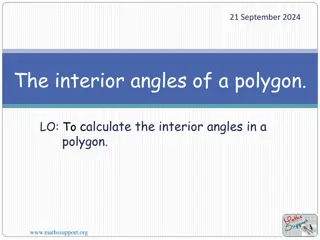Commensurable Triangles: Sides vs. Angles
Delve into the world of commensurable triangles through the lens of sides and angles. Discover the relationships between integer triples, Pythagorean triangles, Heronian triangles, and the fascinating properties that arise from their configurations. Uncover the intriguing patterns and dense sets within the realm of commensurable triangles, offering a unique perspective on geometric structures.
Download Presentation

Please find below an Image/Link to download the presentation.
The content on the website is provided AS IS for your information and personal use only. It may not be sold, licensed, or shared on other websites without obtaining consent from the author.If you encounter any issues during the download, it is possible that the publisher has removed the file from their server.
You are allowed to download the files provided on this website for personal or commercial use, subject to the condition that they are used lawfully. All files are the property of their respective owners.
The content on the website is provided AS IS for your information and personal use only. It may not be sold, licensed, or shared on other websites without obtaining consent from the author.
E N D
Presentation Transcript
Triangular magic Heron triangles (sides), and commensurable triangles (angles), but mostly commensurable triangles H kan Lennerstad, BTH
A rational triangle. 3 2 4 3 h = V5/8 2 4 1 1 Heronian triangle: rational sides and rational area ( all heights rational, since A = bh/2) . 1
First: Pythagorean triangles, which have integer sides and a right angle. 3 4 5 4 3 32 + 42 = 9 + 16 52 = 25 Egyptian h 5 52 + 122 = 25 + 144 132 = 169 (m2 n2)2 + (2mn)2 = (m2 + n2)2 All pythagorean triangles: k(m2 n2), k2mn,k(m2 + n2), Integers k, m, n m > n. (3, 4, 5) gives k=1, m=2, n=1. (5, 12,13) gives k=1, m=3, n=2. And so on. Third height? Heronian triangles that are not right triangles? From area: So h = 12/5 = 2,4. 5h/2 = 3 4/2.
13 5 3 5 4 12
13 5 4 12 3 5
13 5 12
13 25/4 5 5 12 15/4 Gives heronian (13, 12 + 15/4, 25/4)-triangle. Gives heronian (52, 63, 25)-triangle. So: all heights are rational: A = ah1/2 = bh2/2 = ch3/2.
5 5 5 5 3 3 3 3 4 4 4 4 Gives heronian (5,5,8)-triangle. Gives heronian (5,5,8)-triangle. And (5,5,6). And (5,5,6). 5 5 5 5 4 4 4 4 3 3 3 3 All heronians come from a pair of pythagoreans. All heronians come from a pair of pythagoreans.
That was triangles by sides. Now triangles by angles! The angles of a commensurable triangle relate as integers, say n, m and k. Which are relatively prime. Commensurable triangles correspond to integer triples. ?/3 ?/3 ?/3 Then the angles are n?/(n + m + k), m?/(n + m + k) and k?/(n + m + k), making the angle sum ?. The angle ?/(n + m + k) is the root angle the largest angle dividing all three. The generation of the triangle (n, m, k) is n + m + k. Two assumptions on the triple: 1. n, m and k are relatively prime, 2. n m k. Are these interesting triangles? The commensurable triangles form a dense set among the set of triangles, when disregarding size (by for example set the area = 1)? Triangle tree: the child of n-m-k is obtained by adding 1 to n, m or k, as long as the two assumptions are fulfilled. At most three children. The generation number of a commensurable triangle is n + m + k.
Property correspondence ?/3 commensurable triangle Integer triple n, m, k ?/3 ?/3 Right n + m = k Wide isosceles n = m Narrow isosceles m = k Equilateral n = m = k ( =1) Partition of integer: write as a sum of positive integers. 1 = 1 (1 way) 2 = 2 = 1 + 1 (2 ways) 3 = 3 = 2 + 1 = 1 + 1 + 1 (3 ways) Only odd numbers 1 1 distinct numbers 1 1 2 2 2 2 4 = 4 = 3 + 1 = 2 + 2 = 2 + 1 + 1 = 1 + 1 + 1 + 1 (5 ways) 5 = 5 = 4 + 1 = 3+ 2 = 3 + 1 + 1 = 2 + 2 + 1 = 2 + 1 + 1 + 1 = 1 + 1 + 1 + 1 (7 ways) 3 3 6 = 6 = 5 + 1 = 4+ 2 = 3 + 3 = 4 + 1 + 1 = 3 + 2 + 1 = 2 + 2 + 2 = 3 + 1 + 1 + 1 = 2 + 2 + 1 + 1 =2 + 1 + 1 + 1 + 1 = 1 + 1 + 1 + 1 + 1 + 1 (11 ways)
Q1: Can a branch end? Q2: Will all integer triples appear? A1,1: Is always one of the triples (a + 1, b, c) and (a, b + 1, c) and (a, b, c + 1) relatively prime? A1,2: If (a + 1, b) and (a, b + 1) are not relatively prime, then A1,3: a + 1 = Ab , where b is a factor in b. And A1,4: And b = Bb . This gives A1,5: (A B)b = 1. A1,6: Which forces b = 1. A1,7: So if a + 1, b and a, b+1 are not relatively prime, then a and b are relatively prime. A1,8: So then a, b, c + 1 relatively prime. A1,9: Q1 answered: No! A2,1: One of the triples a - 1, b, c and a, b - 1, c and a, b, c - 1 relatively prime. (Similar proof.) A2,2: Q2 answered: Yes!
Number of commensurable triangles of generation g? This is gn. g3 = 1, g4 = 1, g5 = 2, g6 = 2, Same as the number of partitions of the integer g in three terms. Consider regular polygon with n corners. Number of distinct triangles by connecting corners: pn. All are rational with root angle ? /n, at most. Since some belong to an earlier generation. Formula: pn = [(n-3)/6] (n 3 [(n-3)/6] ) + ?n mod 6 p6 = 3. Where ?n = 3, 4 ,5, 1, 1 ,2 (for n= 0, 1, 2, 3, 4, 5). And gn = pn (sum of all gn/k were k|n, n/3 k <n). p3 = 1. g6 = p6 p3 = 3 1 = 2.
Puzzling observations 1. So many numbers with lots of 2:s! And many 3:s. 2. If n = p a prime, then gp gp+1 . Why?? Hints about unseen symmetries Unseen, yet!
2.0 1.5 1.0 0.5 0.5 1.0 1.5 2.0
Thank your for your attention! To be continued (there s more triangular magic, based on the sides)
